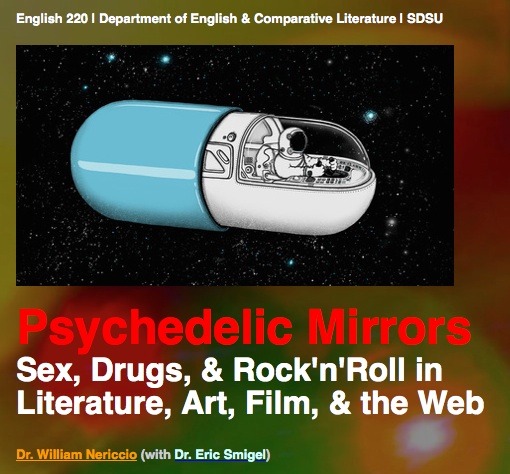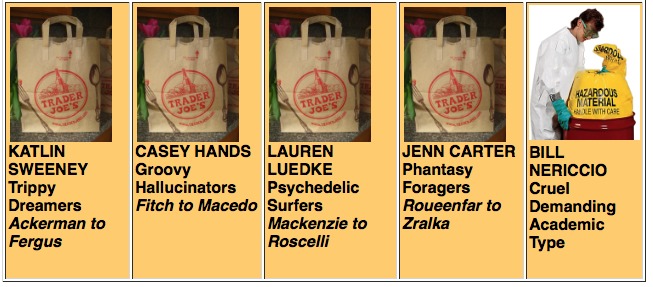 |
| Analytical Imagination Challenge
Numero Dos All essays MUST incorporate research from at least TWO scholarly sources* or they will not even be considered for an A-level grade! All of the other recommendations and suggestions for success mentioned in Analytical Imagination Challenge Numero Uno are still in force for this outing. *(no, Wikipedia is NOT a “scholarly source”—nor is Spark Notes, for that matter--if your research is not coming from a book off the shelf in Love Library, or a legitimate journal hosted on JSTOR or Project Muse, it is probably not a scholarly source. Take care to consult actual ESSAYS, not the one to two page BOOK REVIEWS many of you used in Imagination Challenge Numero Uno) Something to remember: several of the essays below feature works we will not have read together as a class, meaning you have to read ahead and on your own. These prompts have a higher degree of difficulty and come with higher potential rewards. Also remember: when you are doing research, you do NOT have to find an essay that specifically focuses on the work you are writing about. For instance, you decide to write a paper on left-handed hermaphrodites in the work of William Shakespeare. It would not be essential to find a book or article that directly addresses this phenomena in Shakespeare. It would be equally useful to your reader to find research on 'uncommon sexual phenonena' in all literature and then adapt that finding to your particular focus in your essay. If this is NOT clear, ask for more examples in class. Your 3-5 page magical work of cunning critical amazingness is due at the beginning of class on Thursday, November 17, 2016. Place your work into the bag for your team, either: Katlin Sweeney's Trippy Dreamers; Casey Hands' Groovy Hallucinators; Lauren Luedke's Psychedelic Surfers; Jenn Carter's Phantasy Foragers; or Professor Nericcio's Hazmat Bag of Tricks) at the front of the room in the Hallucinatorium, GMCS 333.  Pick ONE of the following prompts--all A-level essays will likely subject these prompts to a healthy amount of metamorphosis, transmogrification, adaptation, and warping! THE BORDER 1. Throughout our discussion of Orson Welles's Touch of Evil and Carlos Fuentes's The Crystal Frontier, we examined how physical borders craft a divide between people, communities, and countries to sustain specific perceptions of power and enforce who we consider to be heroes and villains. Write a critical essay that explores how Miguel Vargas in Touch of Evil and/or Lisandro Chávez in The Crystal Frontier represent/interact with either physical or figurative borders. How do Welles and Fuentes overlap? Where do they contrast? LOVE AND CRISIS 2. Relationship metamorphosis--contrast the representation of relationships/love/crisis found in Matthew Weiner and Semi Chellas's "Far Away Places" Mad Men episode with that of a relationship you find in one of the stories in Carlos Fuentes's The Crystal Frontier. Ultimately, your essay will be concerned with the how relationships (or their implosion) impact on the psyche in contemporary storytelling. CREATIVE OBSESSIONS 3. Proposition: Carlos Fuentes and Orson Welles share obsessive passions that show their works to be intimately intertwined. Expore, contest, or reshape this proposition. THEORY OF THE ESSAY 4. Of all the genres of literature, it is the "ESSAY" that gets the least love. Where novels get mad affection and poetry is still all the rage, the essay, whether it be autobiographical, critical, exploratory, or journalistic, always comes in behind the pack. Write a critical study on the history of the essay clearly situating William Nericcio's curious Tex[t]-Mex in this literary tradition. COMPARATIVE LITERATURE 5. Haruki Murakami, from Japan, and Carlos Fuentes, from Mexico, are two of the more noted novelists of the late 20th and early 21st century. Divided by time and culture, they still end up doing things that are similar when telling a story. Focus your essay on their similarities making use of interviews/articles on both authors as you weave your critical analysis. PHOTOGRAPHY/CINEMA AS PATHOLOGY 6. Both Michelangelo Antonioni, with Blow-Up (focused on a photographer, Thomas), and Sophia Coppola, with Somewhere, (focused on movie star Johnny Marco), create filmed narratives that seem to suggest something screwy happens to human beings when they spend too much time around a camera. Write an essay that explores the idea of camera as pathology--you may want to screen Michael Powell's Peeping Tom before writing this essay--the essays of Susan Sontag may prove useful as well. COMPARATIVE CINEMA: ANXIETY 7. Orson Welles and Michelangelo Antonioni are different artists--however, a closer examination of Touch of Evil and Blow-Up reveals writer/directors with a similar vision, and, even, similar psychological anxieties. Using research into scholarly interpretations of their movies (and interviews with the directors) author a paper that delves into the depths of these psychic anxieties. EXOTIC EROTIC 8. Can Carlos Fuentes and Haruki Murakami be thought of as 'erotic writers.' In an essay that explores the history of the erotic and determines Fuentes's and Murakami's place in this tradition. The Real vs. The Unreal 9. Both Mad Men ("Far Away Places") and Michaelangelo Antonioni’s Blow-Up take place in the rapidly changing world of the 1960s, a decade that ushered in the era of psychedelic drugs and deep, (sometimes) drug-driven existential examinations of the psyche. Furthermore, both the episode “Far Away Places,” by Semi Chellas and Matthew Weiner, and Antonioni's film examine the distinction (or lack thereof) between the real and the unreal. Using the episode and film, as well as carefully selected scholarly articles, craft an essay exploring what the blurred lines between the real and the imagined reveal about the inner-workings of the human psyche. ROLL YOUR OWN 10. Design your own thesis incorporating any two works we covered AFTER October 11, 2016. Share your proposal with me, with a typed-up working title and a supporting paragraph, by Thursday, NOVEMBER 10, 2016—OR you can email it to me at any moment before that class at memo@sdsu.edu. Please make sure to author a well-crafted proposal that outlines the main focus of your proposed study and one that also discloses the scholarly research you will include in your project. |